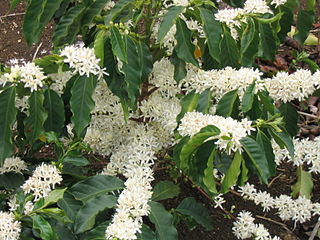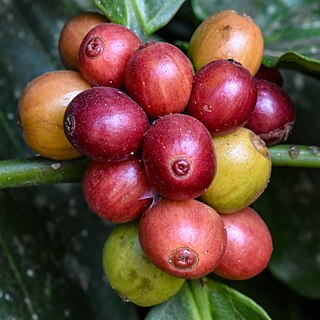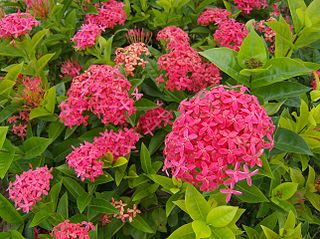
Coffea is a genus of flowering plants in the family Rubiaceae. Coffea species are shrubs or small trees native to tropical and southern Africa and tropical Asia. The seeds of some species, called coffee beans, are used to flavor various beverages and products. The fruits, like the seeds, contain a large amount of caffeine, and have a distinct sweet taste.

Rubiaceae is a family of flowering plants, commonly known as the coffee, madder, or bedstraw family. It consists of terrestrial trees, shrubs, lianas, or herbs that are recognizable by simple, opposite leaves with interpetiolar stipules and sympetalous actinomorphic flowers. The family contains about 14,100 species in about 580 genera, which makes it the fourth-largest angiosperm family. Rubiaceae has a cosmopolitan distribution; however, the largest species diversity is concentrated in the tropics and subtropics. Economically important genera include Coffea, the source of coffee; Cinchona, the source of the antimalarial alkaloid quinine; ornamental cultivars ; and historically some dye plants.
Mock orange or mock-orange typically refers to Philadelphus, a mostly Holarctic genus of shrubs, particularly the species Philadelphus coronarius, which is widely cultivated as an ornamental plant.
Squill is a common name for several lily-like plants and may refer to:

Coffea arabica, also known as the Arabica coffee, is a species of flowering plant in the coffee and madder family Rubiaceae. It is believed to be the first species of coffee to have been cultivated and is the dominant cultivar, representing about 60% of global production. Coffee produced from the less acidic, more bitter, and more highly caffeinated robusta bean makes up most of the remaining coffee production. The natural populations of Coffea arabica are restricted to the forests of South Ethiopia and Yemen.

Coffea canephora is a species of coffee plant that has its origins in central and western sub-Saharan Africa. It is a species of flowering plant in the family Rubiaceae. Though widely known as Coffea robusta, the plant is scientifically identified as Coffea canephora, which has two main varieties, robusta and nganda.
Bachelor's buttons is a common name for several plant species:
Leopard lily is a common name for several plants and may refer to:
Butterfly pea is a common name for several plants and may refer to:
Rosebay is a common name for several plants

Coffea liberica, commonly known as the Liberian coffee, is a species of flowering plant in the family Rubiaceae from which coffee is produced. It is native to western and central Africa, and has become naturalised in areas including Colombia, Venezuela, the Philippines, Borneo and Java.
Coffee is a bitter, hot beverage.
Coffea charrieriana, also known as Charrier coffee, is a species of flowering plant from the Coffea genus. It is a caffeine-free coffee plant endemic to Cameroon in Central Africa. It is the first recorded caffeine-free Coffea in Central Africa, and the second to be recorded in Africa. The first caffeine-free species was previously discovered in Kenya, named C. pseudozanguebariae. The International Institute for Species Exploration at Arizona State University and a committee of taxonomists and scientists voted C. charrieriana as one of the top 10 species described in 2008.

Chiococca alba is a species of flowering plant in the coffee family (Rubiaceae) native to Florida and the extreme southern tip of Texas in the United States, Bermuda, Mexico, Central America, the Caribbean, the Galápagos, and tropical South America. Common names include David's milkberry, West Indian milkberry, cahinca and West Indian snowberry. The specific epithet, alba, means "white" in Latin and refers to the color of its fruits.

Psychotria nervosa, also known as Seminole balsamo or wild coffee, is a shade tolerant medium-sized shrub native to Florida as well as the West Indies and Central and South America. It produces a "small, red, ellipsoid fruit" that resembles "the true coffee bean" in shape and attract birds. Its maximum height ranges from approximately 4–10 feet.
Kapok fibre is a cotton-like plant fibre obtained from the seed pods of a number of trees in the Malvaceae family, which is used for stuffing mattresses and pillows, for padding and cushioning, and as insulation.
Common marigold is a common name for several plants in the family Asteraceae cultivated as ornamentals for their large, generally orange blossoms.

Ixoroideae is a subfamily of flowering plants in the family Rubiaceae and contains about 4000 species in 27 tribes.

Coffea stenophylla, also known as highland coffee or Sierra Leone coffee, is a species of Coffea originating from West Africa.

Coffea racemosa, also known as racemosa coffee and Inhambane coffee, is a species of flowering plant in the family Rubiaceae. It has naturally low levels of caffeine, less than half of that found in Coffea arabica, and a quarter of that in Robusta coffee.








